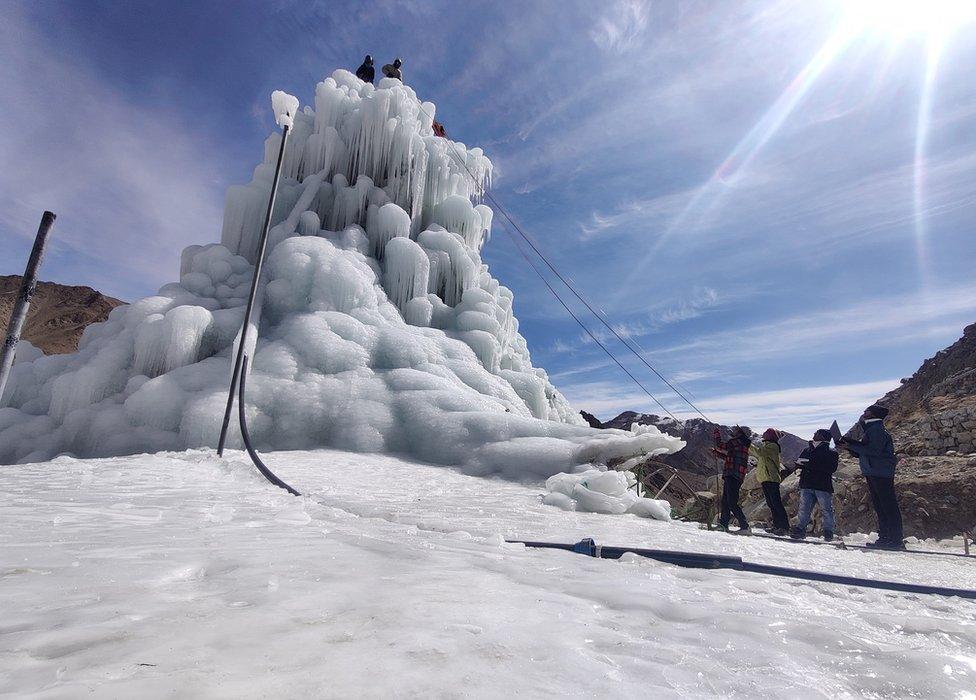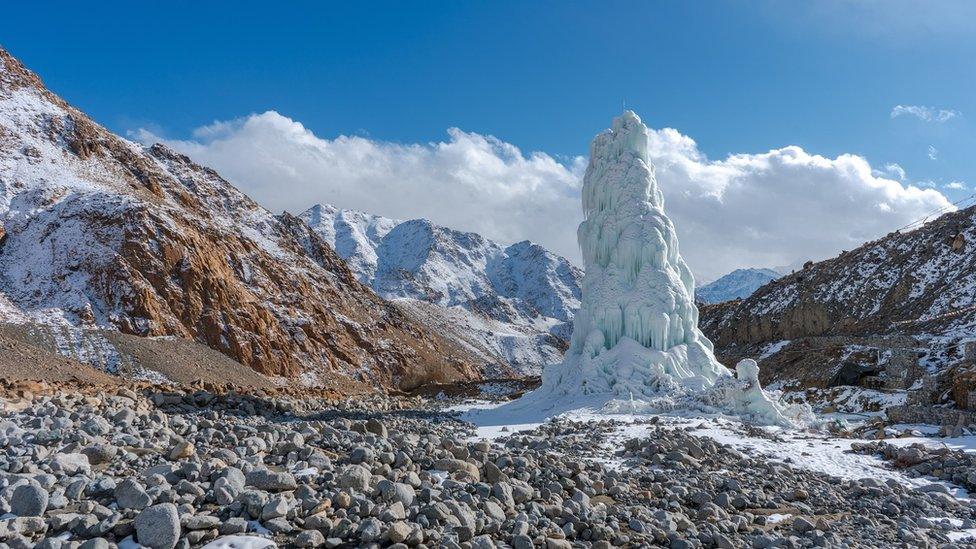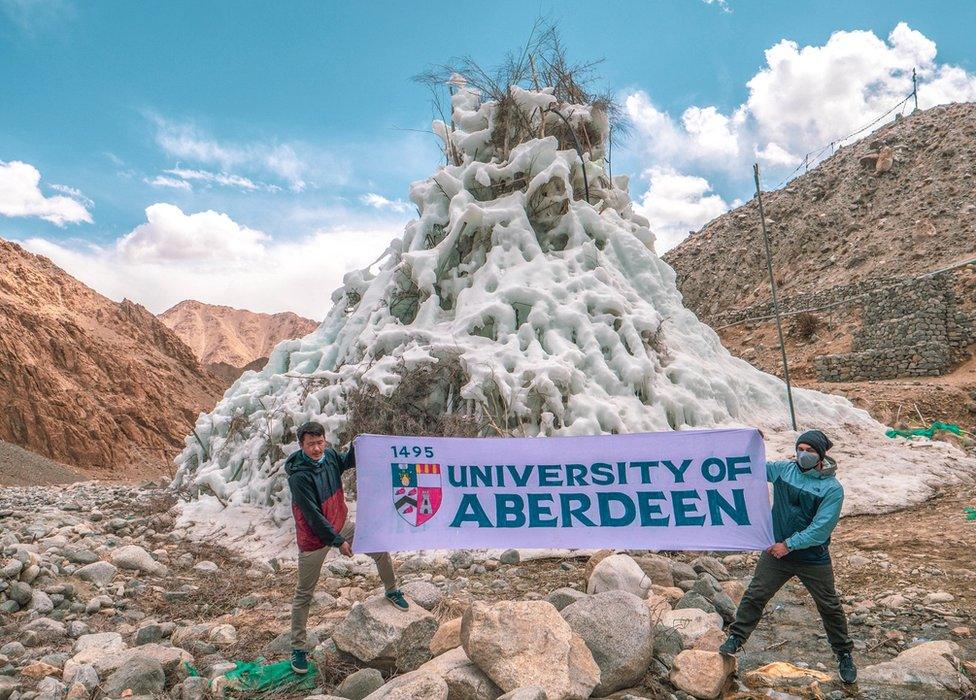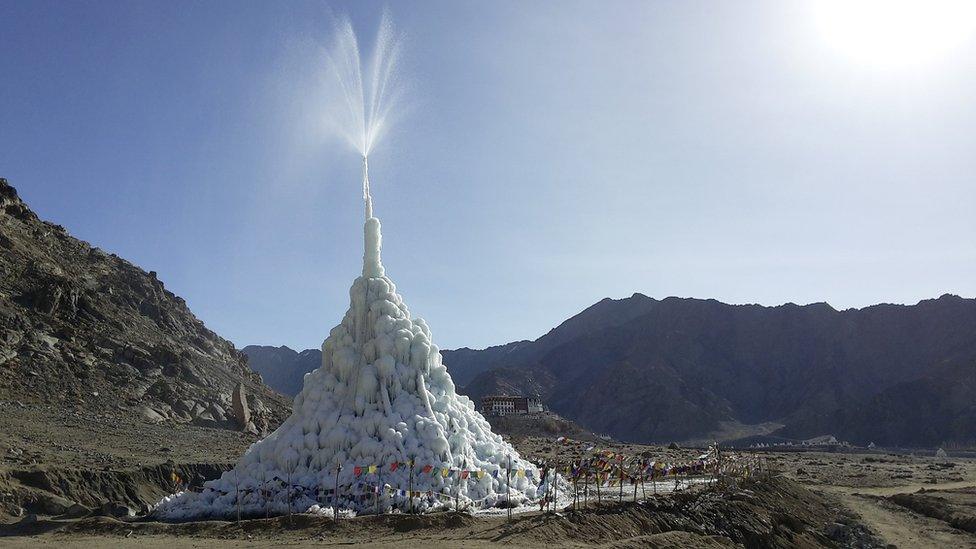Aberdeen scientists develop ice stupas for Himalayan water crisis
- Published

Aberdeen scientists are developing technology invented by Indian engineer Sonam Wangchuk
An artificial glacier designed to solve a water crisis in the Himalayas is being developed by University of Aberdeen scientists.
The glaciers - known as ice stupas - were invented in 2013 by engineer Sonam Wangchuk, but are still "in their infancy" according to researchers.
Stupas release meltwater in the spring which is used for growing crops.
They have been built in Ladakh, northern India, which is one of the most arid places in the world.
Aberdeen's Cryosphere and Climate Change research group is working in the region to help improve the technology so they can be used more widely.
"Our research has shown that mountain glaciers in Ladakh are retreating at an increasing rate," said Prof Matteo Spagnolo, from the university team.
"So it is clear that interventions such as ice stupas are essential."
Why is there a Himalayan water shortage?

In Tangtse village in Ladakh, vast patches of barren land are surrounded by mountains
Most villages in the region experience acute water shortage particularly during the months of April and May, according to the ice stupa project, external.
This is the time when people are competing to water newly planted crops.
By mid-September there are small streams flowing, but by this time they are of little use as farming activity comes to an end.
The problem has worsened as a result of climate change, which is causing natural glaciers to disappear.
In April, a study found that the world's glaciers were melting at an accelerated rate - having lost almost 270 billion tonnes of ice a year over the last 20 years.
The team from Aberdeen, along with the Jawaharlal Nehru University in New Delhi, has shown that glacier shrinkage in Ladakh has also increased at a dramatic pace.
Frequent and extended droughts have threatened crops and therefore the lives of the people living in the coldest, driest parts of the world.
Prof Spagnolo added: "Glaciers are exceptionally good and reliable indicators of climate change. Put in the simplest terms, as temperatures rise, glaciers shrink and may eventually disappear.
"As well as being photogenic, spectacular emblems of climate change, glaciers are also, for many communities, an irreplaceable source of fresh water."
How do ice stupas work?

Pipes are used to create the pyramid-shaped structures that store water
Ice stupas were invented in 2013 by Sonam Wangchuk, a prominent Indian engineer who also co-founded the Himalayan Institute of Alternatives - the organisation is primarily responsible for the development of the technology, alongside the Students' Educational and Cultural Movement of Ladakh.
They are used for storing the wasted water as ice during the winter months, which then melts for use during the arid months.
Pipes are initially buried under the ground, below the frost line, before the final section of the pipe then rises vertically.
Due to the difference in height, temperature, and the gravitational force, pressure builds up in the pipe. The stream water eventually flows up and out from the pipe's raised tip like a fountain.
The sub-zero air freezes the water to gradually form a pyramid-like structure.
Ice stupas can release millions of litres of water each year. They are built next to where water is needed most - on the outskirts of villages near fields.

The University of Aberdeen is working with the Ice Stupa project in northern India
Researchers said their size and shape make them particularly efficient, inexpensive, and easy to maintain.
However they said more work is needed to find a way to stop water freezing in the pipelines and to develop site selection.
They also said there needs to be better understanding of local micro-climates and better distribution of water across multiple users and villages.
Dr Anshuman Bhardwaj, from the research team, said: "We are working closely with our partners in the Ice Stupa project team to help with some of the aspects of the technical and logistical challenges.
"We are also looking to better understand the rate of glacier retreat and how this can inform our strategy going forward."
Related topics
- Published3 October 2017
